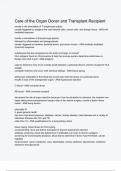Exam (elaborations)
Care of the Organ Donor and Transplant Recipient (1) Questions & 100% Verified Correct Answers with complete solutions (Latest update
Care of the Organ Donor and Transplant Recipient (1) Questions & 100% Verified Correct Answers with complete solutions (Latest update
[Show more]



